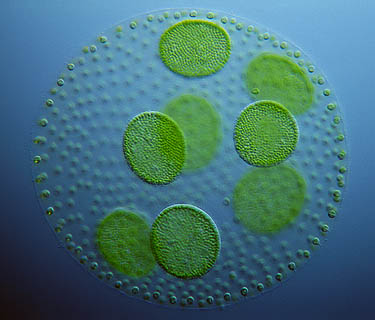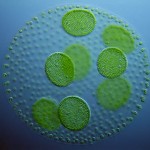
 Algae or common water micro-organisms use energy from sunlight to split water molecules and release hydrogen.
Algae or common water micro-organisms use energy from sunlight to split water molecules and release hydrogen.
Despite of the possibility to have a clean and carbon free fuel in the future this advantage wasn’t speculated yet. Starting from this idea Shuguang Zhang, associate director of MIT’s Center for Biomedical Engineering, and postdocs Iftach Yacoby and Sergii Pochekailov, together with colleagues at Tel Aviv University in Israel and the National Renewable Energy Laboratory in Colorado, have found a way to use bioengineered proteins to flip this preference, allowing more hydrogen to be produced.
“The algae are really not interested in producing hydrogen, they want to produce sugar,” says Yacoby — because the sugar is necessary for their own survival this case the hydrogen is just a byproduct. Using a multitasking enzyme introduced into liquid with algae suppress the sugar production to help them to release more hydrogen and its production is increased by 400 percent.
The sugar production isn’t eliminated as Yacoby said “if it went to zero, it would kill the organism”. So, the research first time demonstrates that the processes carried out by algae could be modified to produce more hydrogen fuel in laboratory conditions. The team plan to continue the study to increase the efficiency of hydrogen fuel production.
The next likely step is to use hydrogen fuel as a renewable energy source. Zhang says: “It is one step closer to an industrial process” so developing further, this process will lead to a viable commercial system for hydrogen fuel manufacturing, being “only a matter of time and money” Zhang added.
The researchers appreciated that such a system could be used to produce hydrogen fuel on a large scale using only water and solar power. The hydrogen fuel could be used to generate electricity in a fuel cell or to power vehicles in a carbon neutral way.
Bengt Nordén, chair of the physical chemistry department at the Chalmers University of Technology in Gothenburg, Sweden, says, “Hydrogen will no doubt be the future’s fuel,” either in pure form or combined to make methane. This particular method of making hydrogen fuel, he says, “is a both simple and environmentally friendly bio-inspired system.”
On the long term, “the only viable way to produce renewable energy is to use the sun, [either] to make electricity or in a biochemical reaction to produce hydrogen,” Yacoby says, and he adds that he “ believes there is no one solution” only many different approaches depending on the location and the end uses. The algae for the process exist everywhere on Earth, and there are no toxic materials involved in any part of the process so hydrogen fuel as a renewable energy source could be obtained everywhere.



